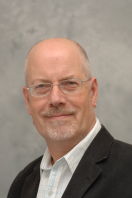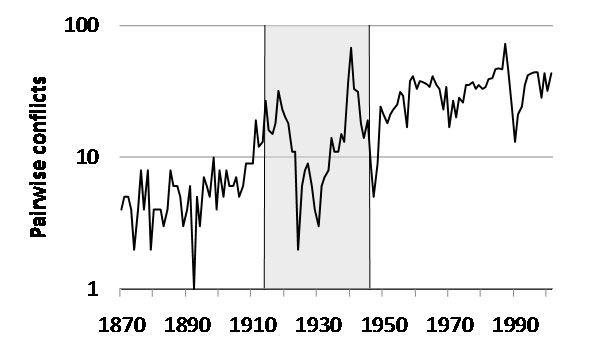Wars steadily increase for over a century, fed by more borders and cheaper conflict
 New research by the University of Warwick and Humboldt University shows that the frequency of wars between states increased steadily from 1870 to 2001 by 2% a year on average. The research argues that conflict is being fed by economic growth and the proliferation of new borders.
New research by the University of Warwick and Humboldt University shows that the frequency of wars between states increased steadily from 1870 to 2001 by 2% a year on average. The research argues that conflict is being fed by economic growth and the proliferation of new borders.
We may think the world enjoyed periods of relative freedom from war between the Cold War and 9/11 but the new research by Professor Mark Harrison from at the University of Warwick’s the Centre for Competitive Advantage in the Global Economy, and Professor Nikolaus Wolf from Humboldt University, shows that the number of conflicts between pairs of states rose steadily from 6 per year on average between 1870 and 1913 to 17 per year in the period of the two World Wars, 31 per year in the Cold War, and 36 per year in the 1990s.
Professor Mark Harrison from the University of Warwick said:
“The number of conflicts has been rising on a stable trend. Because of two world wars, the pattern is obviously disturbed between 1914 and 1945 but remarkably, after 1945 the frequency of wars resumed its upward course on pretty much the same path as before 1913.”
One of the key drivers is the number of countries, which has risen dramatically – from 47 in 1870 to 187 in 2001.
Professor Mark Harrison added:
“More pairs of countries have clashed because there have been more pairs. This is not reassuring: it shows that there is a close connection between wars and the creation of states and new borders. Besides, no matter how you divide it, we have only one planet. Our planet has already seen two world wars. As that experience suggests, you can never be quite sure what little conflicts will not suddenly snowball into much wider, more deadly struggles.”

The fact that inspired the research is illustrated in the figure above. The number of conflicts between pairs of states around the world has been rising since 1870. (“Pairwise conflicts” are measured by the number of pairs of countries in conflicts. Conflicts include everything from full-scale shooting wars and uses of military force to displays of force such as sending warships and closing borders. This doesn’t measure the intensity of violence, but it does capture the readiness of governments to settle disputes by force. Because we look only at wars between states, civil wars are not counted.)
When the researchers have discussed their work with colleagues, the most frequent questions have been about the extra wars since 1945: “Aren’t these just America’s wars?” and “Aren’t these just coalition wars in which many far flung countries join symbolically, yet most never fire a shot?” “No” is the answer to both these questions. If one removes “America’s wars” altogether from the data, it makes no difference: the rising trend is still there. Other scholars have shown that the average distance between countries at war has fallen steadily since the 1950s.
Looking specifically at the countries that have initiated disputes, the researchers show, larger countries (defined by GDP) have tended to make more frequent military interventions, but there has been no increase in this tendency over the 130 years of their study. They also show there is no tendency for richer countries (defined by GDP per head) to make war more often than others, and again this has not changed over 130 years. In other words, the readiness to embark on military adventures is scattered fairly uniformly across the global income distribution.
This raises two sorts of problems. One is that it’s somewhat alarming. The other is that it’s a bit of a puzzle. Much of what we know, or think we know, says this should not be happening. The countries of the world have tended to become richer, more democratic, and more interdependent. The thinkers of the Enlightenment held that these things ought generally to make the world more peaceful. Much political science is built on the idea that the political leaders of richer, more democratic countries have fewer incentives to make war and are more constrained from doing so.
Professor Mark Harrison said:
“We do not think these ideas are wrong, but they are incomplete. Without being certain of the answer, we think political scientists have focused too much on preferences for war (the “demand side”) and not enough on capabilities (the “supply side”). Capabilities may be the missing factor in the story of the rising frequency of wars. We argue that the same factors that should have depressed the incentives for rulers to choose conflict are also increasing the capacity for war. In other words, we are making war more frequently, not because we want to, but because we can.”
The research gives three explanations for this. Firstly, economic growth has made destructive power cheaper, not just absolutely cheaper but cheaper relative to civilian goods. Second, the key to modern states’ acquisition of destructive power was the ability to tax and borrow more than ever before, and the growth of fiscal capacity was hugely assisted by the rise of democracy. Third, war is disruptive of trade, but those countries that succeeded in maintaining external trading links in wartime could wage war more effectively.
Professor Mark Harrison concluded:
“In other words, the very things that should make politicians less likely to want war – productivity growth, democracy, and trading opportunities – have also made war cheaper. We have more wars, not because we want them, but because we can. Finally, under present international arrangements this deep seated tendency is not something that any one country is going to be able to control.”
The full paper entitled the “The frequency of wars” by Mark Harrison and Nikolaus Wolf ![]() , is forthcoming in the Economic History Review.
, is forthcoming in the Economic History Review.
For further information please contact:
Professor Mark Harrison
Centre for Competitive Advantage in the Global Economy
Department of Economics
University of Warwick
44 (0)79 7075 3758
mark.harrison@warwick.ac.uk
Professor Harrison is also a research fellow at the
Hoover Institution on War, Revolution, and Peace at Stanford University.
Peter Dunn, email: p.j.dunn@warwick.ac.uk
Head of Communications, Communications Office, University House,
University of Warwick, Coventry, CV4 8UW, United Kingdom
UK Tel: 024 76 523708 Mobile 07767 655860
PR93 28th June 2011
Download the paper: “The frequency of wars” by Mark Harrison and Nikolaus Wolf ![]()
